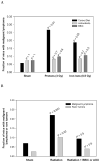Effects of dietary antioxidant supplementation on the development of malignant lymphoma and other neoplastic lesions in mice exposed to proton or iron-ion radiation
- PMID: 18494549
- PMCID: PMC3589916
- DOI: 10.1667/RR1296.1
Effects of dietary antioxidant supplementation on the development of malignant lymphoma and other neoplastic lesions in mice exposed to proton or iron-ion radiation
Abstract
Malignancy is considered to be a particular risk associated with exposure to the types of ionizing radiation encountered during extended space flight. In the present study, two dietary preparations were evaluated for their ability to prevent carcinogenesis in CBA mice exposed to different forms of space radiation: protons and highly energetic heavy particles (HZE particles). One preparation contained a mixture of antioxidant agents. The other contained the soybean-derived Bowman-Birk protease inhibitor (BBI), used in the form of BBI Concentrate (BBIC). The major finding was that there was a reduced risk of developing malignant lymphoma in animals exposed to space radiation and maintained on diets containing the antioxidant formulation or BBIC compared to the irradiated animals maintained on the control diet. In addition, the two different dietary countermeasures also reduced the yields of a variety of different rare tumor types observed in the animals exposed to space radiation. These results suggest that dietary supplements could be useful in the prevention of malignancies and other neoplastic lesions developing from exposure to space radiation.
Figures




Similar articles
-
Dietary supplements reduce the cataractogenic potential of proton and HZE-particle radiation in mice.Radiat Res. 2010 Mar;173(3):353-61. doi: 10.1667/RR1398.1. Radiat Res. 2010. PMID: 20199220
-
Suppression of the later stages of radiation-induced carcinogenesis by antioxidant dietary formulations.Radiat Res. 2011 Jul;176(1):62-70. doi: 10.1667/rr2439.1. Epub 2011 Apr 26. Radiat Res. 2011. PMID: 21520997
-
Effects of dietary supplements on the space radiation-induced reduction in total antioxidant status in CBA mice.Radiat Res. 2006 Apr;165(4):373-8. doi: 10.1667/rr3523.1. Radiat Res. 2006. PMID: 16579649
-
Biological countermeasures in space radiation health.Gravit Space Biol Bull. 2003 Jun;16(2):37-44. Gravit Space Biol Bull. 2003. PMID: 12959130 Review.
-
The Bowman-Birk inhibitor from soybeans as an anticarcinogenic agent.Am J Clin Nutr. 1998 Dec;68(6 Suppl):1406S-1412S. doi: 10.1093/ajcn/68.6.1406S. Am J Clin Nutr. 1998. PMID: 9848508 Review.
Cited by
-
Redox Signaling and Its Impact on Skeletal and Vascular Responses to Spaceflight.Int J Mol Sci. 2017 Oct 16;18(10):2153. doi: 10.3390/ijms18102153. Int J Mol Sci. 2017. PMID: 29035346 Free PMC article. Review.
-
Radioprotectors and mitigators of radiation-induced normal tissue injury.Oncologist. 2010;15(4):360-71. doi: 10.1634/theoncologist.2009-S104. Oncologist. 2010. PMID: 20413641 Free PMC article. Review.
-
Whole-body proton irradiation causes long-term damage to hematopoietic stem cells in mice.Radiat Res. 2015 Feb;183(2):240-8. doi: 10.1667/RR13887.1. Epub 2015 Jan 30. Radiat Res. 2015. PMID: 25635345 Free PMC article.
-
Using electron beam radiation to simulate the dose distribution for whole body solar particle event proton exposure.Radiat Environ Biophys. 2010 Nov;49(4):715-21. doi: 10.1007/s00411-010-0315-z. Epub 2010 Aug 20. Radiat Environ Biophys. 2010. PMID: 20725839 Free PMC article.
-
Dried plum diet protects from bone loss caused by ionizing radiation.Sci Rep. 2016 Feb 11;6:21343. doi: 10.1038/srep21343. Sci Rep. 2016. PMID: 26867002 Free PMC article.
References
-
- Wan XS, Bloch P, Ware JH, Zhou Z, Donahue JJ, Guan J, Stewart J, Kennedy AR. Detection of oxidative stress induced by low- and high-linear energy transfer radiation in cultured human epithelial cells. Radiat Res. 2005;163:364–368. - PubMed
-
- Wan XS, Ware JH, Zhou Z, Donahue JJ, Kennedy AR. Protection against radiation induced oxidative stress in cultured human epithelial cells by treatment with antioxidant agents. Int J Radiat Oncol Biol Phys. 2006;64:1475–1481. - PubMed
-
- Kennedy AR, Ware JH, Guan J, Donahue JJ, Biaglow JE, Zhou Z, Stewart J, Vasquez M, Wan XS. Selenomethionine protects against adverse biological effects induced by space radiation. Free Radic Biol Med. 2004;36:259–266. - PubMed
-
- Guan J, Wan XS, Zhou Z, Ware JH, Donahue JJ, Biaglow JE, Kennedy AR. The effects of dietary supplement agents on space radiation-induced oxidative stress in Sprague-Dawley rats. Radiat Res. 2004;162:572–579. - PubMed
-
- Guan J, Stewart J, Ware JH, Zhou Z, Donahue JJ, Kennedy AR. Effects of dietary supplements on the space radiation-induced reduction in total antioxidant status in CBA mice. Radiat Res. 2006;165:373–378. - PubMed
Publication types
MeSH terms
Substances
Grants and funding
LinkOut - more resources
Full Text Sources
Medical

